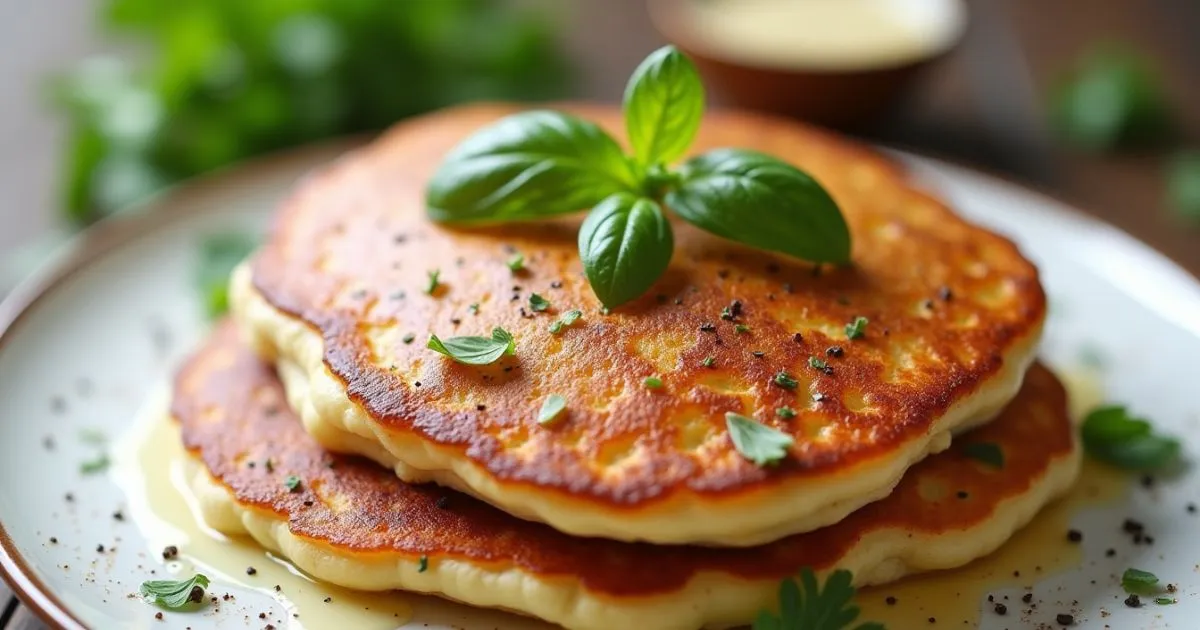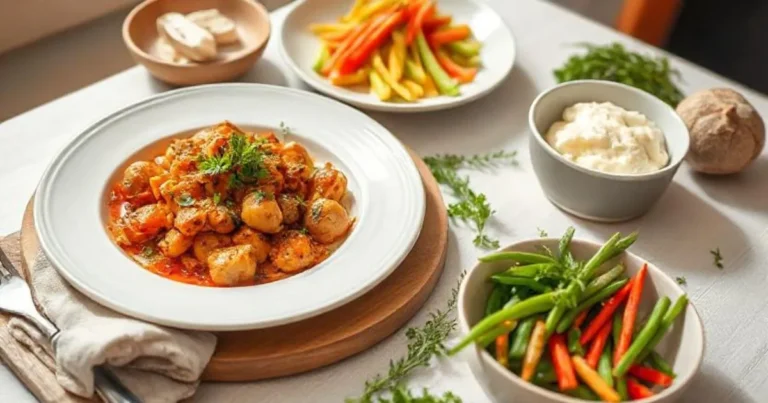Easy Protein Pancake Recipe: 10 Fluffy, High-Protein Breakfast Ideas (Ready in 15 Minutes!)
Picture those lazy Sunday mornings when pancakes meant pure indulgence fluffy stacks swimming in syrup, followed by that inevitable food coma and nagging guilt about all those empty calories. Then you started prioritizing your health, and suddenly pancakes became forbidden territory, something you’d only allow yourself on rare “cheat days.”
I spent years grabbing protein bars while rushing out the door, forcing down chalky shakes that left me hungry an hour later. My mornings felt mechanical, joyless, completely disconnected from the comfort foods I genuinely craved.
Everything shifted when I discovered an easy protein pancake recipe that actually delivered on both taste and nutrition. I was skeptical—how could something this healthy taste like real pancakes? But that first bite erased every doubt. Genuinely fluffy. Deeply satisfying. Packed with enough protein to keep me full until lunch without that mid-morning crash.
The revelation went beyond just flavor. It was about reclaiming breakfast as something worth waking up for rather than another wellness checkbox to tick off. It meant creating food that served both my goals and my happiness without asking me to choose between them.
Whether you’re an athlete seeking quality fuel, a busy professional needing sustainable energy, or someone simply tired of boring breakfasts, these recipes will completely transform your morning routine.
Table of Contents
Why an Easy Protein Pancake Recipe Changes Everything
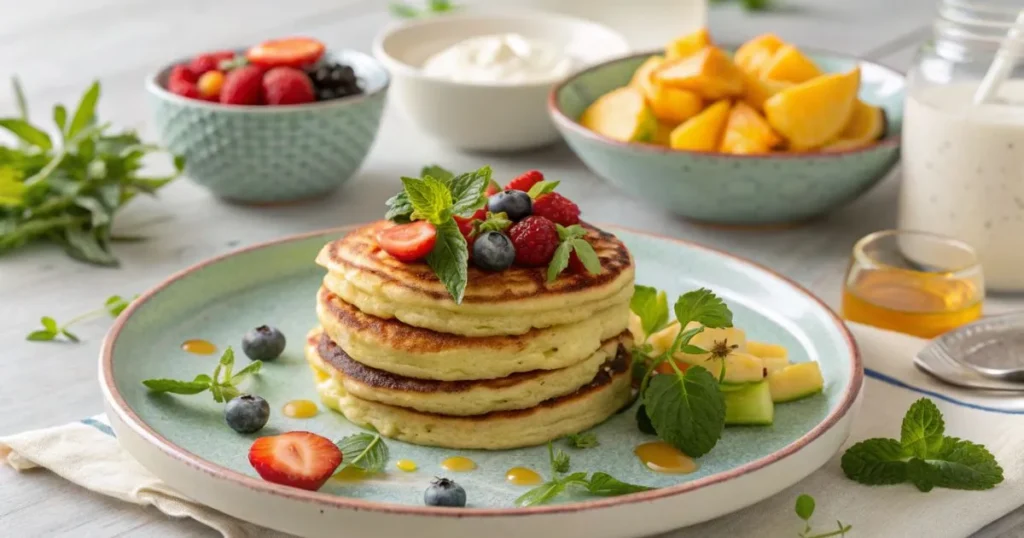
What Traditional Pancakes Get Wrong
Traditional pancakes deliver a massive carbohydrate load—typically thirty to forty grams per serving—with minimal protein to balance things out. You’re looking at just three to five grams of protein in a standard stack. Your blood sugar spikes dramatically, then crashes within an hour or two, leaving you hungrier than when you started.
The psychological damage runs even deeper than the nutritional deficit. When pancakes become “cheat food” that you’re only allowed occasionally, you create an unhealthy restriction-and-binge pattern. Food gets divided into “good” and “bad” categories, making every meal feel like a test of willpower rather than an enjoyable part of your day.
Research published in obesity journals shows that this approach to eating rarely works long-term. The restriction creates cravings that eventually overwhelm willpower, leading to overconsumption followed by guilt and renewed restriction. It’s an exhausting cycle that makes sustainable healthy eating nearly impossible.
How Protein Pancakes Break the Pattern
An easy protein pancake recipe flips this entire dynamic. You’re getting fifteen to thirty grams of protein per serving depending on the recipe you choose. This protein content fundamentally changes how your body processes the meal. Instead of that rapid blood sugar spike and crash, you experience steady energy that sustains you for three to five hours.
The protein triggers the release of satiety hormones that signal fullness to your brain. Studies consistently demonstrate that high-protein breakfasts reduce cravings throughout the day by as much as sixty percent. You’re not fighting hunger or relying on willpower—your body actually feels satisfied.
From a practical standpoint, these recipes typically take just ten to fifteen minutes from start to finish. You’re using simple ingredients that you probably already have in your kitchen. The pancakes freeze beautifully, making them perfect for meal prep. Cook a big batch on Sunday, freeze them in individual portions, and you’ve got grab-and-go breakfasts all week.
Perhaps most importantly, you eliminate that false choice between satisfying food and nutritious food. When pancakes support your goals rather than sabotaging them, breakfast becomes something to look forward to again. You’re building a sustainable relationship with food based on abundance rather than deprivation.
Building Your Perfect Protein Pancake Base
Choosing Your Protein Source
The protein component serves as your foundation, and your options extend far beyond just protein powder. Whey protein isolate works beautifully for most people—it blends smoothly, tastes relatively neutral, and creates light, fluffy pancakes. One scoop typically delivers twenty-five to thirty grams of protein while contributing minimal carbohydrates or fat.
Greek yogurt offers an excellent whole-food alternative. A single cup provides seventeen grams of protein plus beneficial probiotics for gut health. It creates moist, tender pancakes with a slight tanginess that enhances other flavors rather than competing with them. For the best texture, choose plain varieties and control sweetness yourself rather than buying pre-sweetened versions.
Cottage cheese represents the secret weapon that many people overlook. When blended smooth in a food processor, it creates incredibly fluffy pancakes that rival anything you’d get in a restaurant. Half a cup delivers fourteen grams of protein, and the cheese completely disappears into the batter—even people who typically dislike cottage cheese love these pancakes.
Eggs form the foundation of most recipes even when you’re using protein powder or dairy. Each large egg contributes six grams of protein along with healthy fats and nutrients like choline that support brain function. They also provide the structure and binding that holds everything together during cooking.
Understanding Flour Alternatives
Your flour choice dramatically affects both nutrition and texture. Oat flour creates the most familiar pancake experience—hearty and satisfying with a mild, slightly sweet flavor. You can make it yourself by grinding rolled oats in a blender until they reach flour consistency. A quarter cup provides four grams of protein and substantial fiber.
Almond flour works perfectly for low-carb or grain-free versions. It contributes healthy fats and additional protein while keeping carbohydrates minimal. The texture is tender and slightly nutty, though you’ll need to handle these pancakes more gently as they’re more delicate than oat-based versions.
Coconut flour requires special attention because it’s extremely absorbent. You’ll need just one-quarter the amount you’d use of regular flour, and you’ll need more eggs and liquid to compensate for how much moisture it soaks up. The payoff is ultra-low carbohydrate content with substantial fiber.
Some easy protein pancake recipes skip flour entirely, relying solely on protein powder for structure. These versions maximize protein content and work well when you’re specifically focused on post-workout recovery or serious muscle building goals.
Getting the Liquid Balance Right
The liquid component determines your batter consistency, which directly affects final texture. Start conservative—you can always add more liquid, but you can’t remove it once added. Most recipes need about a quarter cup of liquid per scoop of protein powder as a starting point.
Regular milk, whether dairy or plant-based, creates traditional pancake consistency. Almond milk keeps calories low while maintaining neutral flavor. Oat milk adds natural sweetness and creamy texture. Coconut milk brings richness and tropical undertones that pair beautifully with certain flavor profiles.
Mashed banana serves double duty as both liquid and natural sweetener. It adds moisture while contributing potassium and a subtle fruity flavor that complements cinnamon and vanilla beautifully. One medium banana typically provides enough liquid for a single-serving batch.
The key is adjusting gradually. Mix your base ingredients, then add liquid in small increments until you reach a consistency that pours slowly but isn’t thick paste. Let the batter rest for five minutes before cooking—protein powder and certain flours continue absorbing liquid during this rest period, and you’ll get a better sense of whether you need minor adjustments.
Three Essential Recipes to Master First
The Foundation: Classic Protein Powder Pancakes
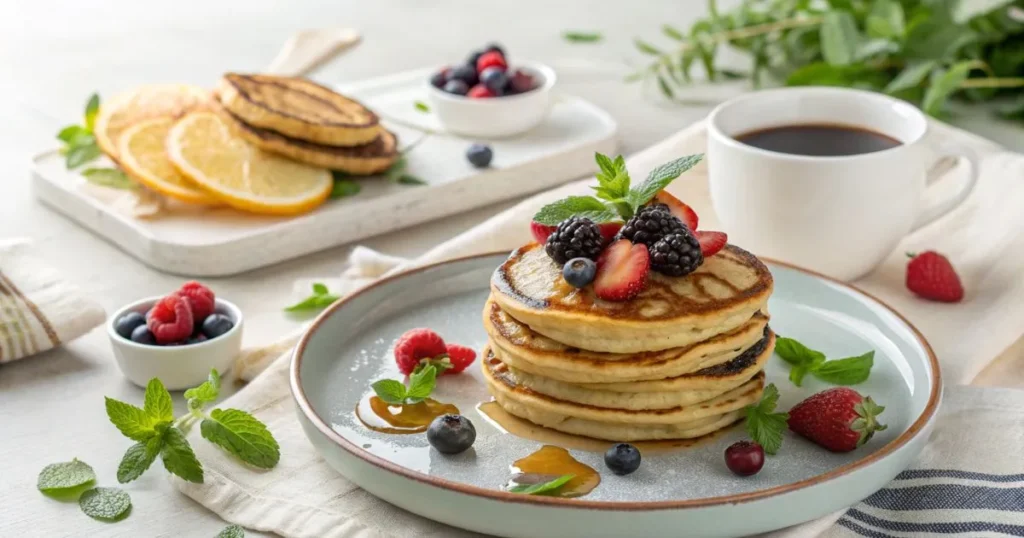
This recipe serves as your master template. Once you nail this technique, you’ll adapt it endlessly based on what you have available and what sounds good on any given morning.
Your ingredient list:
| Ingredient | Amount | Purpose |
|---|---|---|
| Vanilla protein powder | 1 scoop (30g) | Primary protein |
| Rolled oats | 1/2 cup | Texture and fiber |
| Large eggs | 2 | Structure and binding |
| Ripe banana | 1 medium | Natural sweetness |
| Almond milk | 1/4 cup | Consistency |
| Baking powder | 1 teaspoon | Fluffiness |
| Vanilla extract | 1 teaspoon | Depth of flavor |
| Cinnamon | 1/2 teaspoon | Warmth |
| Salt | Pinch | Enhances everything |
Making it happen:
Blend your oats first until they reach flour consistency—this takes about thirty seconds in most blenders. Add all remaining ingredients and blend until smooth, typically another thirty to forty-five seconds. Don’t over-blend, as this can create tough pancakes.
Let your batter rest for five minutes while you heat your pan. This resting period allows the oats to fully absorb liquid and the baking powder to activate. Your batter will thicken noticeably during this time.
Heat a non-stick pan over medium heat. This temperature is crucial—too hot and your pancakes burn before cooking through; too cool and they won’t develop that golden-brown exterior. Lightly coat the pan with cooking spray or a small amount of coconut oil.
Pour about a quarter cup of batter per pancake. Watch for bubbles to form on the surface and the edges to look set and slightly dry—this typically takes two to three minutes. Flip carefully and cook another one to two minutes on the second side.
The entire batch makes four pancakes delivering roughly eighty calories each with seven grams of protein per pancake. Total nutrition: 320 calories, 28 grams of protein, 38 grams of carbs, and 6 grams of fiber for the complete batch.
No Powder Needed: Cottage Cheese Power Pancakes
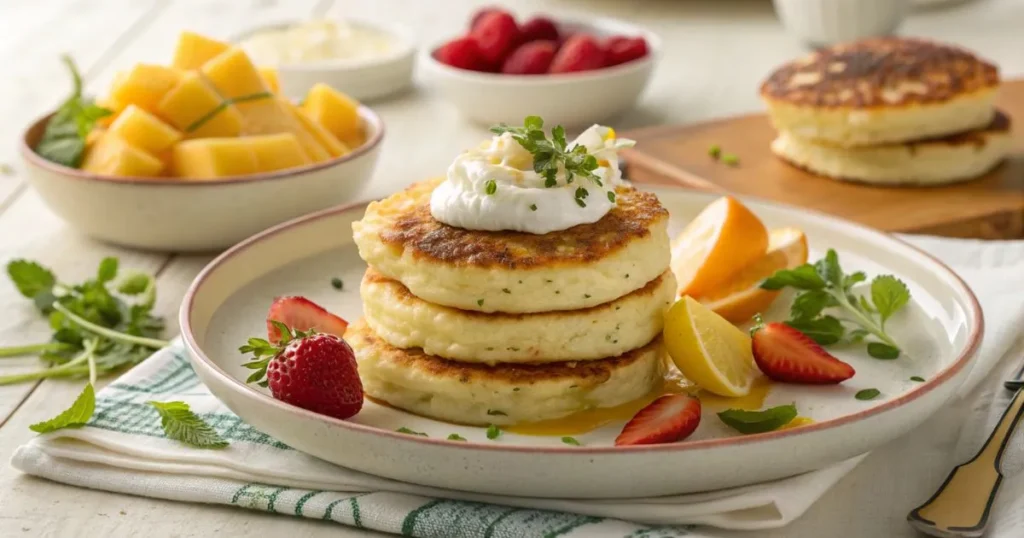
This easy protein pancake recipe proves you don’t need protein powder to create something special. The cottage cheese delivers serious protein while creating texture that’s unbelievably light and fluffy.
What you’ll need:
| Item | Quantity | Protein Contribution |
|---|---|---|
| Cottage cheese | 1 cup | Full-fat or low-fat, 28g |
| Large eggs | 3 | 18g protein |
| Oat flour | 1/2 cup | 4g protein |
| Vanilla extract | 1 teaspoon | Flavor |
| Honey | 1 tablespoon | Natural sweetness |
| Baking powder | 1 teaspoon | Lift |
| Cinnamon | 1/2 teaspoon | Spice |
| Salt | Pinch | Balance |
The technique:
Add cottage cheese and eggs to your blender or food processor. Blend until completely smooth with no visible lumps remaining—this step is absolutely crucial for proper texture. The cheese needs to break down entirely so it disappears into the batter.
Add your remaining ingredients and pulse just until everything comes together. You want thorough mixing but not excessive blending that would toughen the final product.
Cook using the same method described for the classic recipe. These pancakes are particularly fluffy, so handle them gently when flipping. The cheese creates steam pockets during cooking that result in an incredibly light texture.
This batch makes six pancakes at approximately seventy-five calories each. Total nutrition: 450 calories with 50 grams of protein and 45 grams of carbs for the entire recipe.
Low-Carb Champion: Almond Flour Keto Pancakes
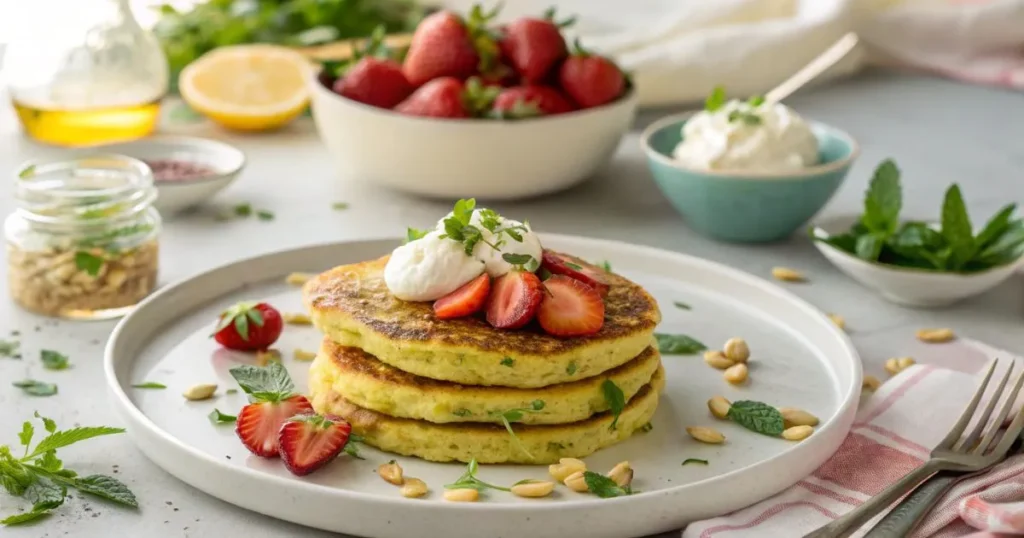
When you’re watching carbohydrate intake but still want genuine pancake satisfaction, this recipe delivers without compromise.
Your shopping list:
| Ingredient | Amount | Keto Benefit |
|---|---|---|
| Almond flour | 1 cup | Low-carb foundation |
| Vanilla protein powder | 1 scoop | Protein boost |
| Large eggs | 3 | Fat and protein |
| Cream cheese | 2 ounces | Softened, adds richness |
| Unsweetened almond milk | 2 tablespoons | Thin to consistency |
| Baking powder | 1 teaspoon | Rise |
| Vanilla extract | 1 teaspoon | Flavor |
| Cinnamon | 1/2 teaspoon | Warmth |
| Stevia or monk fruit | To taste | Zero-carb sweetness |
Bringing it together:
Make sure your cream cheese is fully softened—this ensures smooth blending without lumps. Combine all ingredients in your blender and process until uniformly smooth.
Cook on slightly lower heat than you would for oat-based pancakes. Almond flour burns more easily, so patience pays off here. These pancakes are more delicate, so flip them carefully using a thin, wide spatula.
The recipe yields six small pancakes. Each one contains approximately eighty-seven calories with just three grams of net carbs, six grams of protein, and six grams of healthy fat. For the complete batch: 520 calories, 18 grams net carbs, 35 grams protein, and 35 grams fat.
Pair these with sugar-free syrup or simply butter for a breakfast that keeps you in ketosis while satisfying pancake cravings completely.
Avoiding Common Mistakes
Why Your Pancakes Might Be Failing
Rubbery texture represents the most frequent complaint with protein pancakes. This happens when you over-mix the batter or use too much protein powder relative to other ingredients. Protein molecules create strong bonds when overworked, resulting in tough, dense pancakes that bounce rather than melt in your mouth.
Mix your ingredients just until combined—visible lumps are perfectly acceptable and actually preferable to over-mixed batter. Use the protein-to-flour ratio specified in recipes rather than dumping in extra protein powder thinking more is better.
Pancakes that fall apart when flipping usually indicate insufficient binding agents or premature flipping. Make sure you’re using the recommended number of eggs or egg substitutes. Wait patiently for bubbles to form on the surface and edges to look dry before attempting to flip. Rushing this step causes tears and breakage.
Chalky or gritty texture points to low-quality protein powder or inadequate liquid. Invest in a reputable protein brand—the difference in texture is dramatic and worth the extra cost. Add liquid gradually until you reach proper consistency, and consider including mashed banana or Greek yogurt to add moisture and mask any chalky notes.
Equipment That Makes Success Easier
A quality non-stick pan or griddle makes the biggest difference in your cooking experience. Thin, cheap pans develop hot spots that burn some pancakes while leaving others undercooked. Heavy-bottomed cookware distributes heat evenly and maintains consistent temperature.
A decent blender or food processor creates smooth batter in seconds. Lumpy batter from inadequate blending leads to uneven texture in your finished pancakes. You don’t need an expensive high-powered blender for most recipes, but something beyond a basic personal blender makes the process significantly easier.
A quarter-cup measuring scoop ensures uniform pancake size, which means even cooking and consistent nutrition information. Your pancakes will finish at the same time rather than having some ready while others need more time.
A thin, flexible spatula specifically designed for pancakes makes flipping simple and reduces breakage. Wide surface area provides support while thin edges slide easily under delicate pancakes.
Making Protein Pancakes Work for Your Life
Meal Prep That Actually Saves Time
The true convenience of an easy protein pancake recipe reveals itself through meal prep. Make a triple batch on Sunday afternoon, cool them completely, then stack with small squares of parchment paper between each pancake to prevent sticking.
Transfer your stack to a freezer bag or airtight container and freeze for up to three months. When you need breakfast, grab however many pancakes you want and reheat using your preferred method. Suddenly you’ve got nutritious, satisfying breakfast ready in under two minutes on even the most hectic morning.
Toaster reheating takes two to three minutes and creates slightly crispy edges that many people prefer. Microwave reheating needs just thirty to sixty seconds but produces softer pancakes. Toaster oven at 350°F for five minutes delivers the best texture but takes slightly longer.
Customizing to Your Dietary Needs
Every easy protein pancake recipe in this guide adapts easily to various dietary requirements. For vegan versions, replace eggs with flax eggs (one tablespoon ground flax plus three tablespoons water per egg, let sit five minutes). Use plant-based protein powder and non-dairy milk. Add extra banana for binding and moisture.
For gluten-free needs, ensure your oats are certified gluten-free or use almond flour, coconut flour, or rice flour instead. Most protein pancake recipes are naturally gluten-free anyway since they don’t rely on wheat flour.
Dairy-free versions substitute almond milk or oat milk for regular milk and use vegan protein powder instead of whey. Greek yogurt can be replaced with coconut yogurt or additional banana.
Nut-free recipes use oat flour instead of almond flour and seed butter instead of nut butter if your recipe includes that component. Many easy protein pancake recipes are naturally nut-free already.
Your Breakfast Transformation Starts Now
The power of a good easy protein pancake recipe extends far beyond macronutrients and meal timing. These pancakes represent a fundamental shift in how you relate to food—moving from restriction and guilt to abundance and satisfaction. They prove that taking care of your body doesn’t mean abandoning foods that bring you joy.
When you can wake up knowing that fluffy, delicious pancakes are on the menu and they’re actively supporting your health goals, everything changes. Mornings become something to anticipate rather than rush through. Food becomes an ally in your wellness journey instead of an obstacle requiring constant navigation.
The recipes here provide your foundation, but they’re just the beginning. Once you master the basic techniques, you’ll start improvising based on what you have available and what sounds appealing. You’ll discover your family’s favorites and your own go-to variations for different occasions.
Start with the classic protein powder recipe this weekend. Experience the difference between eating for nutrition and eating for genuine nourishment. Notice how your energy stays stable instead of crashing mid-morning. Feel how satisfied you remain until lunch without that desperate hunger that sends you searching for snacks.
Then explore the other variations. Try the cottage cheese version when you want maximum fluffiness. Make the keto option when you’re watching carbs. Experiment with different flavor combinations and toppings until you’ve built a rotation that keeps breakfast interesting week after week.
Your challenge: Block out thirty minutes this weekend to make your first batch. Choose whichever recipe sounds most appealing, gather your ingredients, and commit to the process. Take that first bite and notice the difference—the texture, the flavor, the way it makes you feel. That single experience will convince you more effectively than any article ever could that healthy eating doesn’t mean sacrificing foods you love. It means making smarter versions that serve both your body and your happiness. Then come back and try every other variation in this guide—your breakfast routine will never look the same.
Did You Try Our Recipe ?
There are no reviews yet. Be the first one to write one.

